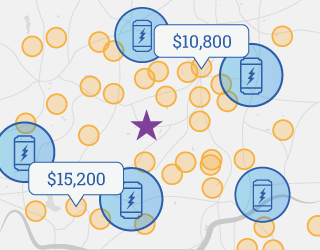With the declining cost of energy storage technology, solar batteries are becoming an increasingly popular addition to solar installations. However, it’s not just residential and commercial solar shoppers who benefit from installing energy storage. In fact, utility-scale battery storage is increasingly playing a major role in the operation of the electric grid, providing cost savings, environmental benefits and new flexibility for the grid.
Large scale energy storage at a glance
As opposed to residential energy storage systems, whose technical specifications are expressed in kilowatts, utility-scale battery storage is spoken about in megawatts (1 megawatt = 1,000 kilowatts). A typical residential solar battery will be rated to provide around 5 kilowatts of power, and to be able to store between 10 and 15 kilowatt-hours of usable energy, as is the case for the Tesla Powerwall 2 and LG Chem RESU 10H. A typical utility-scale battery storage system, on the other hand, is rated in megawatts, and hours of duration, such as Tesla’s Mira Loma Battery Storage Facility, which has a rated capacity of 20 megawatts and a 4-hour duration (meaning it can store 80 megawatt-hours of usable electricity).
Utility-scale storage, also commonly referred to as large-scale or grid-scale storage, has historically been provided by resources such as pumped hydro. In a pumped hydro system, a facility will pump water uphill into a reservoir at times when the cost of electricity is inexpensive (in the middle of the night, for instance), and then running that water back downhill through a turbine when electricity costs are higher and extra energy is needed on the grid. With the combination of declining battery energy storage costs and the increased introduction of renewable energy, batteries are beginning to play a different role at the grid-scale.
The size and functionality of utility-scale battery storage depends upon a couple of primary factors, including the location of the battery on the grid, and the mechanism or chemistry used to store electricity. The most common grid-scale battery solutions today are rated to provide either 2, 4 or 6 hours of electricity at their rated capacity; though, it’s not unrealistic to anticipate that longer-duration batteries will be available someday in the near future. Generally, grid-scale batteries are either paired with a generating resource, such as a wind farm, or placed on the transmission and distribution system, such as at substations, to help balance local electric supply and demand.
Benefits of utility-scale battery storage
There are many ways in which battery energy storage can support the grid. In fact, the analogy used most frequently by utilities and grid operators to describe energy storage is that it’s a “new tool in the toolbox.”
Storage can inherently act like load (charging from the grid when electricity prices and demand are both low) or like a generator (pushing electricity back onto the grid when demand and prices are both high). What’s more, whereas power plants may take minutes or even hours to turn on, battery storage can start injecting electricity onto the grid in milliseconds. This level of flexibility from a resource is unprecedented, and the possibilities for how to harness this capability are endless.
One way in which utility-scale battery storage is particularly helpful is in being paired with renewable resources, such as solar or wind farms. These resources provide a forecastable, predictable amount of generation in every hour, but, due to the nature of sun and wind, do not generate at their maximum capacity every hour. By pairing utility-scale batteries with solar and wind, resource developers can smooth the output from these resources and ensure that renewable energy is injected onto the grid at the times when it is most needed.
Primary providers of utility-scale battery storage
There are a few primary players in the battery energy storage industry at the utility-scale level. Perhaps the best-known provider is Tesla, whose 100 MW battery in South Australia made waves a few years ago. Beyond this deployment, Tesla has also contributed to the Aliso Canyon storage projects to help alleviate the need for the leaky natural gas facility. The company markets both the Powerpack, which is its original utility-scale storage solution, as well as the Megapack, a new product designed for even larger scale applications.
Another major player in the utility-scale battery storage space is AES Energy Storage. Like Tesla, AES also developed a storage project in a couple months’ time in response to the Aliso Canyon gas facility crisis. Recently, AES announced the groundbreaking on a new, 400 MWh battery storage facility in Southern California Edison’s service territory, which will be among the largest battery storage facilities ever brought online.
A Boston-based company, Enel X (formerly EnerNOC), is a leading global player in the energy storage space. The company has developed storage projects for clients and grid operators throughout North America, and just recently announced a new storage project in Peru.
Install solar + storage on your property
Beyond the benefits of installing battery energy storage at the grid-scale, there are plenty of reasons to pair one or more batteries with a solar panel system on your property. Though there may only be one grid-scale solar + storage system, these types of installations are increasing in popularity for homeowners throughout the country, with tens of thousands of systems installed in California alone over the last few years. If you’re interested in taking part in the solar + storage movement, register for a free account on EnergySage to receive custom solar or solar + storage quotes for your home.






